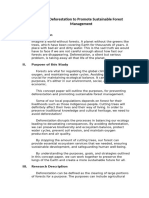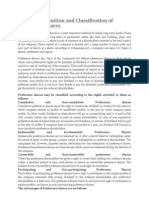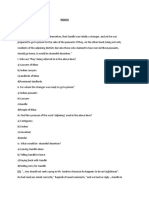0 ratings0% found this document useful (0 votes)
8 viewsDeforestation and Loss of Biodiversity
Deforestation and Loss of Biodiversity
Uploaded by
xluisadrian58Copyright:
© All Rights Reserved
Available Formats
Download as PDF, TXT or read online from Scribd
Deforestation and Loss of Biodiversity
Deforestation and Loss of Biodiversity
Uploaded by
xluisadrian580 ratings0% found this document useful (0 votes)
8 views3 pagesOriginal Title
Deforestation and loss of biodiversity
Copyright
© © All Rights Reserved
Available Formats
PDF, TXT or read online from Scribd
Share this document
Did you find this document useful?
Is this content inappropriate?
Copyright:
© All Rights Reserved
Available Formats
Download as PDF, TXT or read online from Scribd
Download as pdf or txt
0 ratings0% found this document useful (0 votes)
8 views3 pagesDeforestation and Loss of Biodiversity
Deforestation and Loss of Biodiversity
Uploaded by
xluisadrian58Copyright:
© All Rights Reserved
Available Formats
Download as PDF, TXT or read online from Scribd
Download as pdf or txt
You are on page 1of 3
Deforestation and loss of biodiversity
Deforestation or deforestation is a process caused by human action, in which forest
area is destroyed or depleted, usually with the aim of allocating the land to another
activity. Today, it is directly related to industrial activities, such as slash-and-burn for
the expansion of the agricultural frontier to make way for intensive agriculture and
livestock farming. The expansion of urban areas and mining activities also drive
deforestation. The construction of roads and access routes to increasingly remote
forests through illegal logging contributes to deforestation.
Biodiversity loss includes the global extinction of different species, as well as the
local reduction or loss of species in a given habitat, resulting in a loss of biological
diversity. The latter phenomenon can be temporary or permanent, depending on
whether the environmental degradation leading to the loss is reversible through
ecological restoration/ecological resilience or effectively permanent. The current
global extinction has led to a biodiversity crisis, fuelled by human activities that go
beyond planetary boundaries, and which has so far proven irreversible.
Why is deforestation so serious?
Habitat loss: Thousands of plant and animal species depend on forests for survival.
By destroying their homes, many of them face extinction.
Climate change: Trees absorb carbon dioxide, a greenhouse gas. When we cut them
down, we release large amounts of this gas into the atmosphere, contributing to
global warming.
Soil erosion: Forests help protect soil from erosion. Without them, fertile soil is lost,
affecting agriculture and potentially causing flooding.
Disruption of the water cycle: Forests influence the water cycle, regulating local
climate and rainfall. Deforestation can cause droughts or floods.
Causes of deforestation
Agriculture: The expansion of crops and pastures is one of the main causes of
deforestation.
Logging: Illegal and unsustainable felling of trees for wood also contributes to the
problem.
Mining: The extraction of minerals and fossil fuels requires the removal of large areas
of forest.
Urbanization: The growth of cities and the construction of infrastructure destroy
natural habitats.
Consequences of biodiversity loss
The loss of biodiversity is a direct consequence of deforestation and has serious
implications for ecosystems and for ourselves:
Ecological imbalance: The disappearance of species can cause imbalances in
ecosystems, affecting pollination, seed dispersal and other essential processes.
Loss of natural resources: Biodiversity provides a wide range of resources, such as
food, medicines and construction materials.
Impact on human health: The loss of biodiversity can increase the risk of infectious
diseases and reduce the availability of clean water.
What can we do?
Responsible consumption: Choose certified wood products and reduce paper
consumption. Support reforestation initiatives: Participate in reforestation projects or
donate to organizations working on forest conservation. Reduce our carbon footprint:
Adopt more sustainable habits to reduce greenhouse gas emissions. Raise
awareness: Inform family and friends about the importance of protecting forests.
Deforestation is a complex problem that requires long-term solutions. We can all
contribute to protecting our forests and preserving biodiversity for future generations.
Justification of the Problem
Deforestation and the loss of biodiversity are global problems that severely affect
ecosystems, climate, and the quality of human life. Deforestation destroys habitats
and reduces biodiversity, weakening ecosystems and making them more vulnerable
to climate change. Forests are fundamental for climate regulation, as they absorb
carbon dioxide and generate oxygen. Additionally, biodiversity is essential for
maintaining the balance of ecosystems and the environmental services they provide,
such as water purification and pollination.
Consequences
Deforestation and the loss of biodiversity have devastating effects at the
environmental, economic, and social levels. Environmentally, the loss of trees
reduces the capacity to absorb carbon dioxide, accelerating climate change.
Likewise, the decrease in biodiversity affects the ecological services that maintain
soil quality, the water cycle, and climate stability. From an economic standpoint, the
loss of species negatively impacts sectors such as agriculture and tourism. Socially,
indigenous and rural communities, which depend on natural resources, see their
ways of life affected and face the loss of their culture and livelihood.
Influencing Factors
There are multiple factors that drive deforestation and the loss of biodiversity. Among
them, the expansion of agriculture and livestock is one of the main ones, as it
involves the conversion of forest areas into cropland or pasture. Additionally, logging
and mining contribute to the deterioration of ecosystems. Urban growth and the
construction of infrastructure also lead to the fragmentation of natural habitats.
Another factor is climate change, which causes alterations in ecosystems and
increases the vulnerability of many species. The lack of effective environmental
policies and the weak implementation of existing laws exacerbate this problem.
Citizen Actions to Mitigate the Impact
To mitigate deforestation and the loss of biodiversity, citizens can get involved in
different actions. One of them is the promotion of reforestation through tree planting
and the recovery of degraded areas. Also, community participation, getting involved
in conservation and restoration projects. Another that can be efficient and easy for
citizens to do is to support environmental organizations and collaborate with groups
that work on biodiversity protection. Another that has been very common in recent
years is the efficient use of resources, reducing, reusing, and recycling. One that is
also very common is education and awareness, informing and thus raising
awareness about the importance of biodiversity and reforestation.
You might also like
- Causes and Effects of DeforestationDocument3 pagesCauses and Effects of DeforestationYeswanth Raghavendra100% (1)
- Environmental Issues DocumentaryDocument10 pagesEnvironmental Issues Documentaryayaan.6740No ratings yet
- DEPLETION OF FORESTDocument7 pagesDEPLETION OF FORESTlslamic StudioNo ratings yet
- Table of ContentDocument16 pagesTable of ContentSuman VermaNo ratings yet
- Position Paper (Sherra's CM)Document5 pagesPosition Paper (Sherra's CM)Nash CasunggayNo ratings yet
- Deforestation Causes, Effects, and SolutionsDocument3 pagesDeforestation Causes, Effects, and Solutionspolash.tscNo ratings yet
- Deforestation EssayDocument2 pagesDeforestation EssayadingumusNo ratings yet
- English Speaking-DeforestationDocument8 pagesEnglish Speaking-Deforestationikram729No ratings yet
- Deforestation EssayDocument2 pagesDeforestation EssayflynncoultousNo ratings yet
- The Complex Consequences of DeforestationDocument2 pagesThe Complex Consequences of DeforestationJohn Patrick Sanay NuñezNo ratings yet
- Environmental Impact of DeforestationDocument8 pagesEnvironmental Impact of Deforestationmayanksagar4312No ratings yet
- DeforestationDocument3 pagesDeforestationValeria IliesNo ratings yet
- The Causes and Effects of DeforestationDocument1 pageThe Causes and Effects of DeforestationKeJeNo ratings yet
- Quiz 4 - PrefinalDocument2 pagesQuiz 4 - PrefinalRuri DSNo ratings yet
- Concept PaperDocument5 pagesConcept Paperedsondepedroy6No ratings yet
- The Impact of Environmental Changes On Animal and Human HealthDocument25 pagesThe Impact of Environmental Changes On Animal and Human Healthdecastro.thomasNo ratings yet
- Preserving Our Planet The Urgent Need To Address DeforestationDocument4 pagesPreserving Our Planet The Urgent Need To Address Deforestationzorjohn2No ratings yet
- PAULLLLLLLLLDocument7 pagesPAULLLLLLLLLtitus63gdNo ratings yet
- Social Impact of Technology SO245 Assignment 4Document4 pagesSocial Impact of Technology SO245 Assignment 4Osvaldo CangasNo ratings yet
- The Importance of Biodiversity ConservationDocument2 pagesThe Importance of Biodiversity ConservationdrtxypcbzslpbrbqttNo ratings yet
- Int. Env Law FinalDocument24 pagesInt. Env Law Finalvanshika dwivediNo ratings yet
- Human-Impact-on-Nature.pptx_20241119_130111_0000Document7 pagesHuman-Impact-on-Nature.pptx_20241119_130111_0000spotifysongspreNo ratings yet
- Deforestation PowerpointDocument13 pagesDeforestation Powerpointapi-564215636No ratings yet
- TASK 2 Essay DeforestationDocument4 pagesTASK 2 Essay DeforestationDvya Yashu100% (3)
- Deforestation: Deforestation Is The Clearance of Forests byDocument5 pagesDeforestation: Deforestation Is The Clearance of Forests byAbinayaNo ratings yet
- DeforestrationDocument5 pagesDeforestrationchorrcychenNo ratings yet
- The Effects of DeforestationDocument1 pageThe Effects of DeforestationruineD goUrmETNo ratings yet
- Science EssaysDocument9 pagesScience EssaysPrincess Ariane Sionzon LorenzoNo ratings yet
- Deforestation Project ReportDocument2 pagesDeforestation Project Reportseductive.pleasure.sucksNo ratings yet
- environmentDocument3 pagesenvironmentfreebookkeeping1No ratings yet
- Urbanization and Its Impact On Biodiversity LossDocument3 pagesUrbanization and Its Impact On Biodiversity Lossaz8365554No ratings yet
- Environmental DegradationDocument11 pagesEnvironmental DegradationUmar IsaNo ratings yet
- THE ENVIRONMENTDocument6 pagesTHE ENVIRONMENTquachchau0110No ratings yet
- Land Degradation 3rd Yr. Ralph ArcillaDocument7 pagesLand Degradation 3rd Yr. Ralph ArcillaRalph ArcillaNo ratings yet
- Role of Individuals in Environmental ConservationDocument11 pagesRole of Individuals in Environmental ConservationApoorv GoelNo ratings yet
- Assignment 1 (Science) PDFDocument6 pagesAssignment 1 (Science) PDFmariam sharifNo ratings yet
- 7 - The Role of DeforestationDocument2 pages7 - The Role of DeforestationMansoor AsifNo ratings yet
- Deforestation and Its CausesDocument2 pagesDeforestation and Its CausesAlamNo ratings yet
- Factors Affecting Environment and SocietyDocument7 pagesFactors Affecting Environment and SocietyAarchi SinghNo ratings yet
- OUR ENVIRONMENTDocument2 pagesOUR ENVIRONMENTRoshan MeeteiNo ratings yet
- Midterm Term PaperDocument13 pagesMidterm Term PaperXandra LeeNo ratings yet
- Individual Report OutlineDocument5 pagesIndividual Report OutlineepicfunnyNo ratings yet
- World English level2 ed3 lessonE unit8Document4 pagesWorld English level2 ed3 lessonE unit8Karina RuizNo ratings yet
- Environmental Issues in Natural Resources ManagementDocument17 pagesEnvironmental Issues in Natural Resources Managementbernicemensahgud1No ratings yet
- 5 Major Environmental ProblemsDocument7 pages5 Major Environmental ProblemsAdmay Saney CM VBD Pabna DistrictNo ratings yet
- report_mergedDocument6 pagesreport_mergedpriyansh.raj170508No ratings yet
- Biodiversity (1) - 2024 (1) Finalised 6Document15 pagesBiodiversity (1) - 2024 (1) Finalised 6MethinduNo ratings yet
- What Is DeforestationDocument2 pagesWhat Is Deforestationdebo claroNo ratings yet
- Tingkao Vergara Arbol EntryDocument3 pagesTingkao Vergara Arbol EntryJameela TingkaoNo ratings yet
- GoegraphyDocument9 pagesGoegraphyNDATIMANA JOHNSONNo ratings yet
- Environmental StudiesDocument13 pagesEnvironmental StudiesShinestNo ratings yet
- DeforestationDocument9 pagesDeforestationzdhother82No ratings yet
- EnirvonmentgggDocument2 pagesEnirvonmentgggAbdelrhman lafigjNo ratings yet
- Importance of Protecting The EnvironmentDocument2 pagesImportance of Protecting The EnvironmentpyyamberNo ratings yet
- Causes and Effects of DeforestationDocument3 pagesCauses and Effects of DeforestationNhật NữNo ratings yet
- EnvDocument2 pagesEnvmedo.farg50No ratings yet
- Environmental Degradation - English ProjectDocument2 pagesEnvironmental Degradation - English ProjectSyed Ahmad MohsinNo ratings yet
- Biodiversity Loss: The Effects of Habitat Destruction On The WorldDocument4 pagesBiodiversity Loss: The Effects of Habitat Destruction On The WorldMax FieldNo ratings yet
- Causes of DeforestationDocument3 pagesCauses of DeforestationZakaria GhaniNo ratings yet
- SongsDocument152 pagesSongsprincess_iresh94167% (6)
- KethubothDocument827 pagesKethubothlesandarNo ratings yet
- Competitive Analysis of Employee Engagement in 3 Companies of FMCG Industry Dabur Pepsico. NestleDocument3 pagesCompetitive Analysis of Employee Engagement in 3 Companies of FMCG Industry Dabur Pepsico. Nestlesaloni bhardwajNo ratings yet
- Addiction 911 MagazineDocument21 pagesAddiction 911 MagazineBeverly Carballo - MoguelNo ratings yet
- Resource and Development Class 10 Notes Social Science Geography Resource'Document5 pagesResource and Development Class 10 Notes Social Science Geography Resource'Anuj DadhichNo ratings yet
- APT ResumeDocument3 pagesAPT Resumesparshjs1998No ratings yet
- WAEC Chemistry Practical Questions and Answers 2022 (100 Sure) Expo Answers - JoberplanetDocument1 pageWAEC Chemistry Practical Questions and Answers 2022 (100 Sure) Expo Answers - JoberplanetSidney MarlowNo ratings yet
- Preference SharesDocument3 pagesPreference SharesDipti AryaNo ratings yet
- Declaration and Affidavit of Phillip Hanley-1!21!2018Document3 pagesDeclaration and Affidavit of Phillip Hanley-1!21!2018phillip_hanley_2No ratings yet
- Matel ToysDocument8 pagesMatel ToysArun AhlawatNo ratings yet
- Ascaño, Jr. v. Jacinto, Jr. (Legal Ethics Review)Document4 pagesAscaño, Jr. v. Jacinto, Jr. (Legal Ethics Review)Danielle DacuanNo ratings yet
- By:-Khushi Mittal: Intention To Create A Legal RelationshipDocument5 pagesBy:-Khushi Mittal: Intention To Create A Legal RelationshipUmaNo ratings yet
- Japanese Hard Way Easy WayDocument41 pagesJapanese Hard Way Easy WayD MasNo ratings yet
- MCQ's On English (Lecturership Written Test)Document2 pagesMCQ's On English (Lecturership Written Test)Hussain UmarNo ratings yet
- The Tiger KIng Question BankDocument4 pagesThe Tiger KIng Question Bankcaptain delhiNo ratings yet
- FX Trader of The Year Contest 2008: More Than 650 Participants RegisteredDocument1 pageFX Trader of The Year Contest 2008: More Than 650 Participants RegisteredRaja RajNo ratings yet
- 2016 UCPB Annual Report UpdatedDocument236 pages2016 UCPB Annual Report UpdatedPat Dela CruzNo ratings yet
- Tacul Faculty and Staff ProfilesDocument2 pagesTacul Faculty and Staff ProfilesLembert CasinilloNo ratings yet
- Sequence of Service Table D Hote Menu: Ni Luh Denti Damayanti 18110111101 MP/B3Document5 pagesSequence of Service Table D Hote Menu: Ni Luh Denti Damayanti 18110111101 MP/B3Denti DamayantiNo ratings yet
- COMPAÑIA GENERAL v. CITY OF MANILADocument2 pagesCOMPAÑIA GENERAL v. CITY OF MANILAMichael Mendoza MarpuriNo ratings yet
- Tracer Study Manual: Child Labour Impact Assessment ToolkitDocument191 pagesTracer Study Manual: Child Labour Impact Assessment ToolkitAllan Jay Tabara BugnaNo ratings yet
- Indigo Imp QstnsDocument3 pagesIndigo Imp QstnsSaad KhanNo ratings yet
- Littel WomenDocument4 pagesLittel WomenWaseem AhmadNo ratings yet
- Exemple Introduction Dissertation Madame BovaryDocument7 pagesExemple Introduction Dissertation Madame BovaryHelpWritingAPaperSingaporeNo ratings yet
- 961 Beer CaseDocument3 pages961 Beer CaseDio Ardana PramandikaNo ratings yet
- Allahabad TT Master TPT DLR ATF Contact No of TT Crew & TransporterDocument16 pagesAllahabad TT Master TPT DLR ATF Contact No of TT Crew & Transporterbreakingnews7773148No ratings yet
- G.I. Tagged ProductsDocument6 pagesG.I. Tagged ProductsAbhishek SoniNo ratings yet
- Travel OrderDocument2 pagesTravel OrderEdwin RealezaNo ratings yet
- BBA III Year Complete Syllabus 1Document55 pagesBBA III Year Complete Syllabus 1Pranav PremlaniNo ratings yet
- Resolution No.03 SERIES 2012Document2 pagesResolution No.03 SERIES 2012Maria Rubynilla PolicanNo ratings yet

























































































